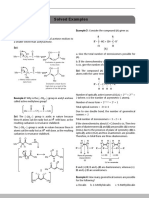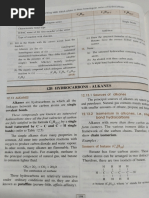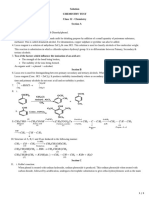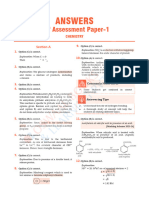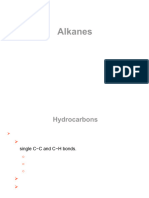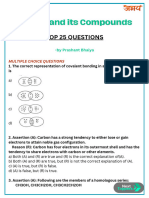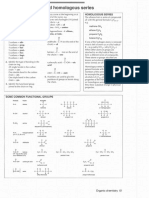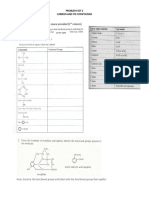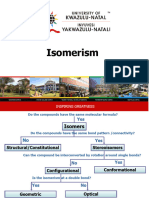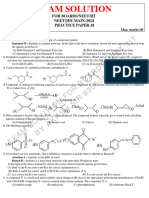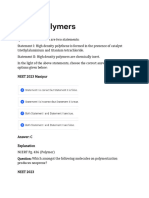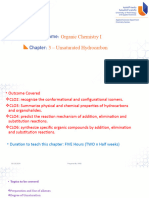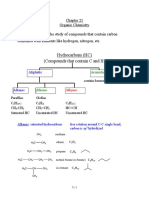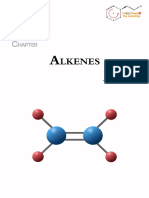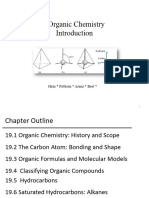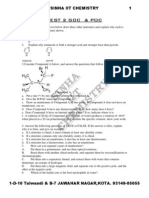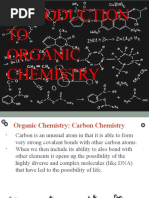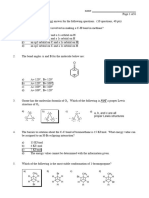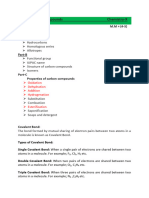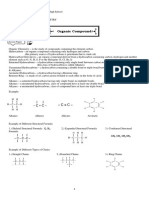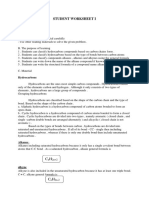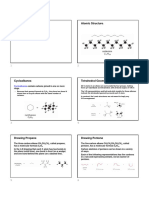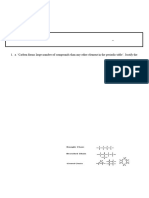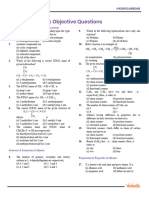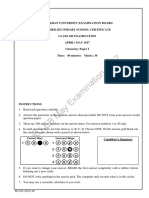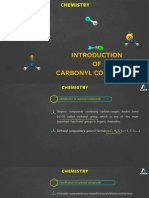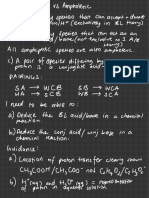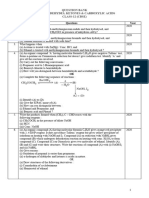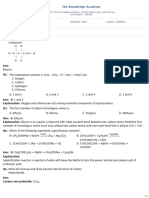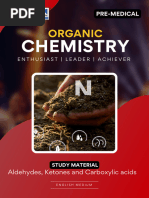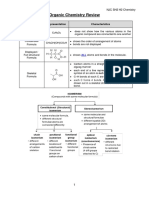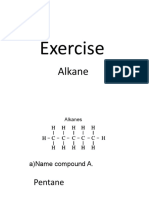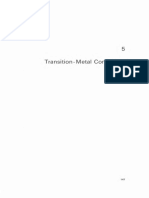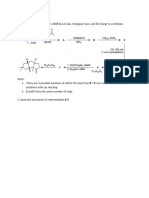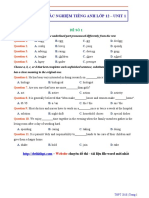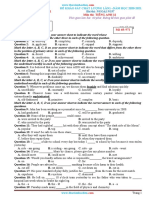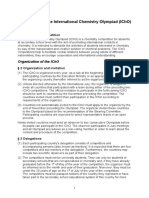0 ratings0% found this document useful (0 votes)
77 viewsCapnellene
Capnellene
Uploaded by
Kiệt LýA synthesis of (+)-Capnellene begins with separating the more sterically hindered isomer A from isomers A and B of C8H12O. Isomer A is used in the synthesis while isomer B is discarded. The structures of intermediates A through M in the synthesis are to be drawn.
Copyright:
© All Rights Reserved
Available Formats
Download as PDF, TXT or read online from Scribd
Capnellene
Capnellene
Uploaded by
Kiệt Lý0 ratings0% found this document useful (0 votes)
77 views1 pageA synthesis of (+)-Capnellene begins with separating the more sterically hindered isomer A from isomers A and B of C8H12O. Isomer A is used in the synthesis while isomer B is discarded. The structures of intermediates A through M in the synthesis are to be drawn.
Original Title
BT5
Copyright
© © All Rights Reserved
Available Formats
PDF, TXT or read online from Scribd
Share this document
Did you find this document useful?
Is this content inappropriate?
A synthesis of (+)-Capnellene begins with separating the more sterically hindered isomer A from isomers A and B of C8H12O. Isomer A is used in the synthesis while isomer B is discarded. The structures of intermediates A through M in the synthesis are to be drawn.
Copyright:
© All Rights Reserved
Available Formats
Download as PDF, TXT or read online from Scribd
Download as pdf or txt
0 ratings0% found this document useful (0 votes)
77 views1 pageCapnellene
Capnellene
Uploaded by
Kiệt LýA synthesis of (+)-Capnellene begins with separating the more sterically hindered isomer A from isomers A and B of C8H12O. Isomer A is used in the synthesis while isomer B is discarded. The structures of intermediates A through M in the synthesis are to be drawn.
Copyright:
© All Rights Reserved
Available Formats
Download as PDF, TXT or read online from Scribd
Download as pdf or txt
You are on page 1of 1
(+)-Capnellene
Consider the following synthesis of (+)-Capnellene
A and B are isomers of C8H12O. The A isomer is separated and used in the synthesis, while B is
discarded. Notably, A is the more sterically hindered isomer between A and B.
Draw the structures of A-M.
You might also like
- Week 6B - IsomerismDocument4 pagesWeek 6B - IsomerismMaxNo ratings yet
- 9 Isomerism-Exercise PDFDocument36 pages9 Isomerism-Exercise PDFTHE INDIAN JOKERNo ratings yet
- Assignment Isomerism & Stereochemistry-2023Document3 pagesAssignment Isomerism & Stereochemistry-2023Pratyush Raj SaranNo ratings yet
- 191 Reactions Producing StereoisomersDocument3 pages191 Reactions Producing StereoisomersM DiNo ratings yet
- Ch-4 Carbon and Its Compounds - 3 Marker QuestionsDocument2 pagesCh-4 Carbon and Its Compounds - 3 Marker QuestionsArshita KarayatNo ratings yet
- Organic - Reagents FinalDocument27 pagesOrganic - Reagents FinalSankar AdhikariNo ratings yet
- Lakhmir Singh Solutions For Class 10 Chemistry Chapter 4 Carbon and Its Compounds PDFDocument24 pagesLakhmir Singh Solutions For Class 10 Chemistry Chapter 4 Carbon and Its Compounds PDFNeetu DuaNo ratings yet
- Adobe Scan Jan 02, 2025Document6 pagesAdobe Scan Jan 02, 2025richu260612No ratings yet
- Solution 1085111Document3 pagesSolution 1085111S.PrajanNo ratings yet
- 12 Carboxylic Acid Sderivatives NotesDocument37 pages12 Carboxylic Acid Sderivatives NotesFatema ZahraNo ratings yet
- Https App.oswaalbooks.com Download Sample-qp Subsolution 856Self Assessment Paper-1 (5)Document7 pagesHttps App.oswaalbooks.com Download Sample-qp Subsolution 856Self Assessment Paper-1 (5)mk8518056No ratings yet
- Carbon and Its Compounds: Chapter - 14Document27 pagesCarbon and Its Compounds: Chapter - 14Swathi VeldhandiNo ratings yet
- 2 Alkanes, Radical Halogenation (1)Document74 pages2 Alkanes, Radical Halogenation (1)mmujahidheerNo ratings yet
- Hidrocarburos IiDocument7 pagesHidrocarburos IiJavier Eduardo Corzo LequericaNo ratings yet
- DPP-Carbon and Its Compound (Prashant Kirad)Document12 pagesDPP-Carbon and Its Compound (Prashant Kirad)HARSHIT IS LIVE100% (1)
- CBSE-Class-X Science CHP 01Document1 pageCBSE-Class-X Science CHP 01hem mishraNo ratings yet
- Study Guide - Topic 10Document8 pagesStudy Guide - Topic 10Salahuddeen AbubakarNo ratings yet
- Stereoisomerism VKP SirDocument49 pagesStereoisomerism VKP SirSandeep ReddyNo ratings yet
- CHEM1090 Final - Module 2Document10 pagesCHEM1090 Final - Module 2Dani R.No ratings yet
- ProblemSet2 CarbonanditscompoundsDocument2 pagesProblemSet2 Carbonanditscompoundsguineivherkaye.canares.23No ratings yet
- Org 4Document4 pagesOrg 4الشيء والضيNo ratings yet
- 2002 Olympiad Chemistrywith AnswersDocument17 pages2002 Olympiad Chemistrywith AnswersArshiya FatimaNo ratings yet
- Isomerism StudentsDocument29 pagesIsomerism Studentsneriskagov04No ratings yet
- Neet 18-1Document5 pagesNeet 18-1h47xa4t5No ratings yet
- Cambridge IGCSE™ Chemistry 4th Edition (Bryan Earl, Doug Wilford) (Z-Library)Document18 pagesCambridge IGCSE™ Chemistry 4th Edition (Bryan Earl, Doug Wilford) (Z-Library)Muhammad TayyabNo ratings yet
- Wa0011.Document9 pagesWa0011.gauravsalunkhe367No ratings yet
- Sample file_ICSE Chapter-wise Mini Test SeriesDocument6 pagesSample file_ICSE Chapter-wise Mini Test Seriesgananigowda102009No ratings yet
- Org1 Chap3 Unsaturated HC-MAB-TAB (Feb2023)Document43 pagesOrg1 Chap3 Unsaturated HC-MAB-TAB (Feb2023)Tapan K LaiNo ratings yet
- Chapter 21 Organic ChemistryDocument6 pagesChapter 21 Organic Chemistry韩博阳王子源王东方杨迪捷这四个傻逼No ratings yet
- 15 AlkenesDocument12 pages15 AlkenesCH NOUMANNo ratings yet
- Organic ChemistryDocument58 pagesOrganic ChemistryShima SenseiiNo ratings yet
- 7-Introduction To Organic ChemistryDocument20 pages7-Introduction To Organic Chemistryjbrsbw4ddcNo ratings yet
- TEST 2 GOC & POC Tough by S.K.sinha See Chemistry Animations atDocument3 pagesTEST 2 GOC & POC Tough by S.K.sinha See Chemistry Animations atmyiitchemistryNo ratings yet
- 1) Organic Chemistry IntroDocument57 pages1) Organic Chemistry IntrofhdlakNo ratings yet
- Organic NomenclatureDocument12 pagesOrganic Nomenclatureitbwng100% (1)
- TS% Acide Alpha Amine%Document3 pagesTS% Acide Alpha Amine%Ibrahima DiopNo ratings yet
- Exam1 02anDocument6 pagesExam1 02andyntoko07No ratings yet
- notes, Carbon compounds X-ChemDocument33 pagesnotes, Carbon compounds X-ChemramijstudyNo ratings yet
- Adv Chem Q4 T1 Organic CompoundDocument3 pagesAdv Chem Q4 T1 Organic CompoundXY PLAYZNo ratings yet
- Student Worksheet I: HydrocarbonsDocument5 pagesStudent Worksheet I: HydrocarbonsSandra Clarisa OctaniaNo ratings yet
- Hydrocarbons Derivatives - Amides PDFDocument4 pagesHydrocarbons Derivatives - Amides PDFAhmed HammadNo ratings yet
- Organic Chemistry Revision MatsogellaDocument117 pagesOrganic Chemistry Revision MatsogellaEyami MngqibisaNo ratings yet
- 1_Bonding and aromaticityDocument10 pages1_Bonding and aromaticityNguyễn DungNo ratings yet
- Smith Ch04Document13 pagesSmith Ch04k616108No ratings yet
- 285a99e0-b2f1-43bd-9721-c8cba2cb9a86Document7 pages285a99e0-b2f1-43bd-9721-c8cba2cb9a86two.one.one.nineNo ratings yet
- Organ Notes Super TwoDocument220 pagesOrgan Notes Super TwoJohn VukeniNo ratings yet
- XI-NEET M-2 Chemistry Final Booklet-pages (1)Document22 pagesXI-NEET M-2 Chemistry Final Booklet-pages (1)Akaash ChakrabartyNo ratings yet
- Chemistry HSSC II Paper IDocument12 pagesChemistry HSSC II Paper ImehmoodaNo ratings yet
- Carbonyl CompoundsDocument539 pagesCarbonyl CompoundsArcco PlayzNo ratings yet
- Topic 8 - Acids and Bases 2Document1 pageTopic 8 - Acids and Bases 2Vashti ChowlaNo ratings yet
- UNIT 12 ALDEHYESDocument8 pagesUNIT 12 ALDEHYESayush.gamingvlogsNo ratings yet
- CHEMISTRY-XIIDocument8 pagesCHEMISTRY-XIIoiyakanniNo ratings yet
- ALDEHYDESDocument8 pagesALDEHYDEStrayambakeswarreddyNo ratings yet
- Question Bank Unit 12 Aldehydes, Ketones & Carboxylic Acids CLASS-12 (CBSE)Document8 pagesQuestion Bank Unit 12 Aldehydes, Ketones & Carboxylic Acids CLASS-12 (CBSE)Dharshitha67% (3)
- Chem CH 4 - 10TH-SCIENCE-AnswersheetDocument25 pagesChem CH 4 - 10TH-SCIENCE-Answersheetaishik.dasgupta12798No ratings yet
- Theory- Aldehydes , Ketones and Carboxylic AcidDocument38 pagesTheory- Aldehydes , Ketones and Carboxylic Acidkinocet923No ratings yet
- 24 Organic Review 2023Document37 pages24 Organic Review 2023Elyssa En YingNo ratings yet
- Exercise AlkaneDocument17 pagesExercise Alkanerudi_zNo ratings yet
- Shuru Ka MergedDocument60 pagesShuru Ka Mergedoffx.prem90998No ratings yet
- B2-ĐTDocument26 pagesB2-ĐTKiệt LýNo ratings yet
- MikanokryptinDocument6 pagesMikanokryptinKiệt LýNo ratings yet
- Screenshot 2021-10-29 at 10.04.57Document7 pagesScreenshot 2021-10-29 at 10.04.57Kiệt LýNo ratings yet
- 2025-05-25 Anorganische Chemie II-Koordinationschemie EnglischDocument188 pages2025-05-25 Anorganische Chemie II-Koordinationschemie EnglischKiệt LýNo ratings yet
- Rusolimpiadolimp2017eng - Tour2 - Sol - PDF 3Document28 pagesRusolimpiadolimp2017eng - Tour2 - Sol - PDF 3Kiệt LýNo ratings yet
- ReserpineDocument1 pageReserpineKiệt LýNo ratings yet
- BT10Document2 pagesBT10Kiệt LýNo ratings yet
- Httpsauthors - Library.caltech - edu10520914TR000574 05 Chapter-5 PDFDocument41 pagesHttpsauthors - Library.caltech - edu10520914TR000574 05 Chapter-5 PDFKiệt LýNo ratings yet
- Bài Tập Theo Từng Unit Unit 1: Home Life Có Đáp ÁnDocument11 pagesBài Tập Theo Từng Unit Unit 1: Home Life Có Đáp ÁnKiệt LýNo ratings yet
- Hirsutene (Yu)Document1 pageHirsutene (Yu)Kiệt LýNo ratings yet
- 100 Câu trắc nghiệm tiếng Anh lớp 12 Unit 1 - File word có đáp ánDocument19 pages100 Câu trắc nghiệm tiếng Anh lớp 12 Unit 1 - File word có đáp ánKiệt LýNo ratings yet
- Đề gồm có 4 trang, 50 câu: Bài thi: NGOẠI NGỮDocument5 pagesĐề gồm có 4 trang, 50 câu: Bài thi: NGOẠI NGỮKiệt LýNo ratings yet
- Regulations of The International Chemistry Olympiad (Icho) : General StatementDocument16 pagesRegulations of The International Chemistry Olympiad (Icho) : General StatementKiệt LýNo ratings yet

